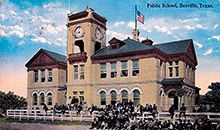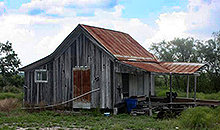Main Menu
Bee County Data
Bee County Communities & Places
Genealogy & History Links by USGHN
Important Bee County Addresses
Sponsors
Bee County Neighbors
Goliad County, Texas
Karnes County, Texas
Live Oak County, Texas
Refugio County, Texas
San Patricio County, Texas
Other Websites
Welcome to Bee County Texas Genealogy & History Network!
Welcome to the Bee County, Texas Genealogy & History Network. Our purpose is to provide visitors with free resources for genealogical and historical research. To share your genealogy or history information, send an email to txghn@outlook.com and we will happily include it here. For other Texas Counties, visit the Texas Genealogy & History Network state website and go to the appropriate county. Thanks for visiting and good luck with your research! |
|
About Bee County, Texas...

Bee County is fifty miles northwest of Corpus Christi and 146 miles southeast of Austin. Beeville is the county's largest town and seat of government.
Bee County has been the site of human habitation for several thousand years. Artifacts recovered in the region suggest that the earliest human inhabitants arrived around 6,000 to 10,000 years ago and camped along the creek valleys. At the time of the first contact with Europeans, various Karankawa bands inhabited the eastern part of the future county, while Lipan Apaches and Borrados roamed the northwest and southwest sections.
The first permanent settlers, Jeremiah O'Tool, his sons Martin and Michael, and James O'Reilly, sailed from Ireland in 1826. Women and children arrived in 1829 and helped to establish the community of Corrigan.
 Eleven Bee County landowners, including Timothy Hart, William Quinn, James O'Conner, and James and William St. John, were among the signers of the Texas Declaration of Independence. During the Texas Revolution many of the settlers fled to New Orleans, but most returned, and in the 1840s and 1850s a small but steady stream of settlers moved to the area.
Eleven Bee County landowners, including Timothy Hart, William Quinn, James O'Conner, and James and William St. John, were among the signers of the Texas Declaration of Independence. During the Texas Revolution many of the settlers fled to New Orleans, but most returned, and in the 1840s and 1850s a small but steady stream of settlers moved to the area.
Bee County was established shortly after the settlement of the Cart War, which originated ten miles east of the site of Beeville. The county, named for Barnard E. Bee, Sr., was formed from San Patricio, Goliad, Refugio, Live Oak, and Karnes counties on December 8, 1857, and officially organized on January 25, 1858. Beeville was located on Medio Creek, near Medio Hill, where the first post office had been established in 1857.
Bee County as a whole was spared the worst effects of the Civil War. By the early 1870s its fortunes began to recover. The most important economic event in the early postwar period was the great cattle  boom. Many postwar cattle drives to the north followed the Chisholm Trail until about 1877, when that route was replaced by the Dodge or Western Trail.
boom. Many postwar cattle drives to the north followed the Chisholm Trail until about 1877, when that route was replaced by the Dodge or Western Trail.
The railroads contributed to the rise of the farming economy. The railroads not only opened up new markets outside the county, but also brought large numbers of new settlers. Between 1870 and 1890 the population of the county nearly quadrupled. Many of the new settlers were recent immigrants, drawn to the area by its mild climate and abundant land.
During the early 1920s large-scale tenant farming was introduced. Most tenants were recent arrivals unable to buy land. During the Great Depression of the 1930s, many fell victim to falling prices for agricultural products and by 1940 fewer than half of the tenants who had farmed a decade before were still on the land.
 In 1929 oil and gas were discovered at Pettus, and revenues and jobs from the oilfields helped to offset some of the affects of the depression. But the economy did not begin to recover until World War II, when several military installations were opened in and around Beeville. In 1954 the first United States Navy all-jet base opened at Naval Auxiliary Air Station in Beeville.
In 1929 oil and gas were discovered at Pettus, and revenues and jobs from the oilfields helped to offset some of the affects of the depression. But the economy did not begin to recover until World War II, when several military installations were opened in and around Beeville. In 1954 the first United States Navy all-jet base opened at Naval Auxiliary Air Station in Beeville.
Oil and gas extraction form the other mainstay of the local economy. In the early 1990s oil production averaged some 800,000 barrels annually; between 1930 and 1991 crude production was 99,091,271 barrels.
Hunting leases and camping draw numbers of tourists to the area. Among the leading attractions are the Beeville Art Gallery and Museum, the annual Western Week held in October, the Diez y Seis de Septiembre (one of the fiestas patrias) and nearby Choke Canyon State Park and Lake Corpus Christi.
 The county has a total area of 880 square miles, of which 879.9 square miles is land and 0.1 square miles (0.01%) is water. The population recorded in the 1860 Federal Census was 910. The 2010 census recorded 31,861 residents there.
The county has a total area of 880 square miles, of which 879.9 square miles is land and 0.1 square miles (0.01%) is water. The population recorded in the 1860 Federal Census was 910. The 2010 census recorded 31,861 residents there.
Neighboring counties are Karnes County (north), Goliad County (northeast), Refugio County (east), San Patricio County (southeast), and Live Oak County (west). The county seat is Beeville. Other communities in the county include Blue Berry Hill, Mineral, Normanna, Pawnee, Pettus, Skidmore, Tuleta, Tulsita, and Tynan.
Bee County, Texas Records
Birth Records - The Texas Department of State Health Services has records from 1903 to present. Records for the last 75 years considered private and will only be provided to certain individuals. To obtain current information on who may obtain a record, how to submit a request and an official request form, see the Texas Department of State Health Services website or write to Texas Vital Records, Department of State Health Services, P.O. Box 12040, Austin, TX 78711-2040.
For older birth records you will have to write to the County Clerk of the applicable county. The existence of birth records prior to 1903 will vary widely from county to county. Local historical societies and genealogy collections in local libraries may be able to provide some information.
Death Records - The Texas Department of State Health Services has records from 1903 to present. Records for the last 25 years considered private and will only be provided to certain individuals. To obtain current information on who may obtain a record, how to submit a request and an official request form, see the Texas Department of State Health Services website or write to Texas Vital Records, Department of State Health Services, P.O. Box 12040, Austin, TX 78711-2040.
Marriage Records - The Texas Department of State Health Services can provide a verification letter of marriage for Texas marriages from 1966 to present. This is NOT a marriage license. To obtain a certified copy of a marriage license you must contact the County or District Clerk in the county or district where the marriage took place.
Local historical societies and genealogy collections in local libraries may be able to provide some information.
Divorce Records - The Texas Department of State Health Services can provide a verification letter of divorce for Texas divorces from 1968 to present. This is NOT a copy of the divorce decree. To obtain a certified copy of a copy of the divorce decree you must contact the County or District Clerk in the county or district where the divorce took place.
Local historical societies and genealogy collections in local libraries may be able to provide some information.




